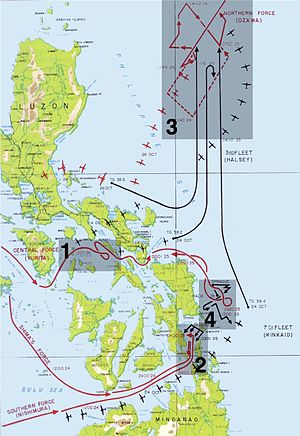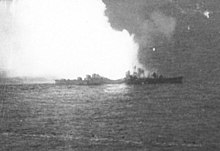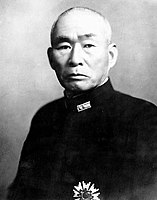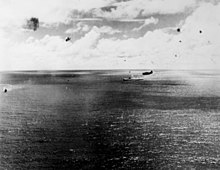Battle of Leyte Gulf
Sea and Air Battle in Leyte Gulf
Part of: World War II, Pacific War

The course of the battle
Overview - Pacific War
Reconquest of the Philippines (1944-1945)
Leyte - Operation Te and Operation Wa - Leyte Gulf - Mindoro - Luzon - Manila - Palawan - Visayas - Mindanao
The naval and air battle of Leyte Gulf (sometimes referred to as the Battle of Leyte Gulf or of Leyte) took place in the waters of the Philippines from 23 to 26 October 1944 during the Pacific War in World War II. The Imperial Japanese Navy attempted to repel the landing operation of Allied forces in the Philippines initiated from 17 October by launching a massive attack on the US fleet. Under the umbrella term "Battle of Leyte Gulf", four independent but strategically related engagements are being fought. Leyte Gulf is a bay-like sea area between the islands of Leyte and Samar where Allied transport ships dropped troops. The battle involved 173 U.S. and 63 Japanese warships, not including transports and smaller ships used as destroyers. The battle marked Japan's last serious attempt to halt the Allied advance in the Pacific.
Previous story
In the fall of 1944, the Japanese naval leadership firmly expected further large-scale landing operations by the Allies after they had conquered the archipelago of the Marianas in the summer. The Japanese had already lost the military initiative in 1942 in the battle of Midway. For each of the next targets in question - the Philippines, Formosa (today's Taiwan), the Ryūkyū Islands, or the Japanese motherland itself - a separate defense plan called Sho was drawn up.
For the US supreme commanders, however, a landing in the Philippines was not yet a foregone conclusion. Originally it was thought to proceed step by step. It was planned to land after the conquest of various smaller islands only on 20 December on the Philippines. Alongside this came the idea of establishing airfields only on the Philippine island of Mindanao, while the main strike was to be made against Formosa and the Chinese mainland. Against this plan the commander-in-chief of the Southwest Pacific forces General MacArthur successfully protested to President Roosevelt: One should not abandon the pro-American Philippine population, to whom MacArthur had promised at the beginning of 1942 to return as liberators. After carrier-based air attacks on the Philippines met with little opposition in mid-September, not only was MacArthur's demand accepted, but the date of the landing was moved up to October 20.
The approach of the forces
The conquest of various smaller islands in the maritime area around the Philippines and New Guinea, such as Peleliu, Morotai, and Ulithi, provided the framework for the U.S. buildup. MacArthur was assigned additional units of Admiral Chester W. Nimitz's Central Pacific forces. Commanding the 3rd Fleet with its aircraft carrier groups was Admiral William F. Halsey. In the weeks leading up to the landing, this fleet systematically decimated Japanese air forces in the Philippines area, destroying a total of 1,200 aircraft. Japanese counterattacks managed to damage only two U.S. cruisers. However, the Japanese leadership reported the sinking of eleven aircraft carriers, two battleships, and three cruisers - a fatal exaggeration that led to more Japanese fighters being dispatched to the area to destroy the "remnants" of the Allied fleet. This miscalculation led to the Japanese reinforcements being destroyed as well.
Japanese naval forces were divided between the mother country and Indonesia because of oil supply shortages caused by Allied submarine action. When U.S. ships began mine-clearing operations in Leyte Gulf on 17 October and advance parties landed, Japanese Navy Commander-in-Chief Admiral Toyoda Soemu triggered Defense Plan Sho-1. Due to the dispersal of forces, Japanese ships were to run to Leyte Gulf separately in four groups and proceed against the landing fleet:
- A formation of aircraft carriers with escort ships, which lay in home waters, was to approach the battle area from the north as a decoy and to draw the American aircraft carriers of Task Force 38 towards them. A destruction of the carriers used as bait was thereby accepted.
- While the U.S. carriers were thus moving away from the Gulf, the remaining units-battleships, cruisers, and destroyers-were to enter Leyte Gulf in three groups from the west and fight down the American ships with their artillery.
Ships
(CV=Aircraft Carrier; CVL=Light Aircraft Carrier; CVE=Command Carrier; BB=Battleship; CA=Heavy Cruiser; CL=Light Cruiser; DD=Destroyer)
Japanese Armed Forces
| Name of the association | Commander | Ships |
| Support group | Ozawa | 1 CV, 3 CVL, 2 BB, 3 CL, 8 DD |
| 1st Combat Group A | Kurita | 5 BB, 10 CA, 2 CL, 15 DD |
| 1st Combat Group C | Nishimura | 2 BB, 1 CA, 4 DD |
| Second Battlegroup | Shima | 2 CA, 1 CL, 4 DD |
| Total: | 1 CV, 3 CVL, 9 BB, 13 CA, 6 CL, 31 DD |
allied forces
| Name of the association | Commander | Ships |
| TG 77.2 | Oldendorf | 6 BB, 3 CA, 2 CL, 15 DD |
| TG 77.3 | Berkey | 1 CA, 2 CL, 6 DD |
| TG 77.4 | T.Sprague/C.Sprague/Stump | 18 CVE, 27 DD |
| TF 38 | Halsey | 8 CV, 8 CVL, 4 BB, 5 CA, 9 CL, 57 DD |
| Total: | 8 CV, 8 CVL, 18 CVE, 10 BB, 9 CA, 13 CL, 105 DD |
Among them two heavy cruisers and two destroyers of the Australian Navy.
Start of the landing operation
→ Main article: Battle of Leyte
On 18 October, an Allied force of six older battleships and five cruisers, Task Group (TG) 77.2 under Admiral Jesse B. Oldendorf, began bombarding the coast. On the 20th, the landing of Allied forces began, and on the same day the bulk of the Japanese battle fleet under Admiral Takeo Kurita of Singapore and the aircraft carrier group under Admiral Jisaburō Ozawa departed from the Inland Sea of Japan. On the 22nd, after a stop in Brunei, the battle fleet, now divided into two battle groups under Kurita and Vice Admiral Shōji Nishimura, headed for Leyte Gulf. Kurita's unit included five battleships, including Yamato and Musashi, the largest battleships ever built, ten heavy cruisers and two light cruisers with 15 destroyers. Nishimura commanded two battleships, one heavy cruiser and four destroyers. The formations were to run north (Kurita) and south (Nishimura) of Samar Island and "heckle" the invasion fleet. Behind Nishimura followed a smaller force of three cruisers and four destroyers under Vice Admiral Kiyohide Shima.
The day after the landing began, 132,000 men with 200,000 tons of supplies had already landed with little resistance from the Japanese Army. The carriers lying east of Samar were essentially covered by the battleships of TG 77.2 and the 18 escort carriers of TG 77.4, while the main American force, TF 38, cruised east of Luzon.
On 23 October, the American submarines Darter and Dace attacked the Japanese main Kuritas west of Palawan, sinking the heavy cruisers Atago and Maya and damaging the cruiser Takao so badly that she had to return to Brunei. In an attempt to overtake and finally sink the Takao, the Darter ran onto a reef and had to be abandoned; the crew was rescued by the Dace. Based on contact reports from the two boats, TF 38's aircraft carriers were positioned east of Luzon and Samar. Shore-based Japanese aircraft attacked one of the carrier groups the next day and were able to damage the light carrier Princeton so severely that it had to be abandoned and sunk in the early evening. Kurita, meanwhile, continued with his decimated force into the Gulf.

The American fleet on the way to the Gulf of Leyte
.jpg)
Japanese 65,000-ts battleship Yamato
_afire.jpg)
The light carrier USS Princeton with the cruiser Reno providing assistance. The carrier's explosion also killed 85 of the crew of the cruiser Birmingham, which had come alongside to fight the fire.
Course of the individual battles
The Battle of the Sibuyan Sea
Between 8 a.m. and 9 a.m. on 24 October, the two Japanese battle groups were spotted by reconnaissance aircraft. The southern Japanese unit Nishimura was attacked by them, with the old battleship Fusō sustaining light damage. The main strike, however, was made by Halsey's carriers against the northern Kuritas unit, which had no cover of its own fighters-all land-based aircraft were used to attack the American carriers. In the waves of attacks that followed, several of Kurita's ships were damaged; the cruiser Myōkō so badly that she retreated to the west. The Musashi was so badly hit that she was left behind the rest of the force. The last of the five attack waves attacked only the Musashi, scoring no fewer than 19 torpedo and 17 bomb hits that caused the ship to sink. Kurita initially set an evasive course, but soon steered back toward the San Bernardino Strait separating Samar from Luzon on Toyoda's orders. He could no longer hope to encounter the American invasion fleet during the night hours, however - it could not be reached before 7 a.m., which would again expose his units to the danger of American air attack. His force was now down to four battleships, six heavy cruisers and two light cruisers with their destroyer escorts.
The Battle of Surigao Street
While the main force lay under constant air attack, Nishimura and Shima proceeded south of it according to plan toward Surigao Strait to enter Leyte Gulf from the south. This intention was recognized by the U.S. High Command; the task of blocking passage through the Strait fell to the old battleships of TG 77.2 Oldendorfs. These patrolled the road in classic keel line as Nishimura's force approached at about 02:30 on 25 October, having been struggling for hours with the unsuccessful attacks of American speedboats. Here the last battle between battleships in the history of naval warfare unfolded.
The US destroyer divisions began radar-guided massive torpedo attacks at 3 o'clock. One torpedo hit the Fusō, which broke up and sank after half an hour. Likewise, three of the four Japanese destroyers were hit and disabled; two of them sank. The other battleship Yamashiro was also hit by a torpedo. Nishimura, despite everything, continued on his way, running directly at the U.S. battleships and cruisers. The American keel line ran across in front of the Japanese, allowing them to use all their guns, while the Japanese ships could only fire with their forward turrets, a practice known in naval warfare theory as "crossing the T". The American ships also had radar-guided fire and could fire and hit at over 20 km, while the Japanese could only lock on and fire unsuccessfully at the forward American cruiser wing during the entire battle at all. At 03:51, the Americans opened fire and within minutes covered the Japanese ships with so many hits that they turned away and tried to escape to the south. However, the Yamashiro was hit by two more torpedoes at 04:11, sinking her for good. Accidentally, there were numerous American hits on the forward operating destroyers Smoots, especially the Albert W. Grant, which caused almost all of the American personnel losses in this battle.
A few minutes later, Shima's following force arrived, recognizing the disastrous course of the operation and turned back after the light cruiser Abukuma was torpedoed by fast boats and Shima's flagship was rammed by the nearly maneuverless heavy cruiser Mogami. It was sunk by aircraft the next day (as was Shima's flagship, the heavy cruiser Nachi, off Manila later). After the banged-up Mogami and the previously damaged destroyer Asagumo were also sunk in the early morning hours, only one destroyer, the Shigure, remained of Nishimura's group.
The Battle of Cape Engaño
While American carrier planes were attacking Kurita's battle fleet on the afternoon of 24 October, Ozawa's approaching carrier fleet was sighted north of Luzon. Admiral Halsey considered this group a prime target and regrouped his fleet. The battleships, including Admiral Halsey's flagship USS New Jersey, and a number of cruisers were taken out of the carrier groups and formed TF 34 under Vice Admiral Willis A. Lee with a total of six battleships, two heavy cruisers, two light cruisers, and 18 destroyers. Three of the carrier groups of Task Force 38 and the TF 34 just formed then ran north to intercept the Japanese carrier battle group.
This left no forces to cover the San Bernardino Straits and thus the landing forces and escort carriers against the Japanese medium attack group under Admiral Kurita (the U.S. carrier group TG 38.1 under Admiral John S. McCain had been en route to Ulithi for refueling and rearming since 22 October and was recalled too late to intervene significantly).
This risk was taken by Admiral Halsey, who believed that the fighting of the previous day had so weakened the middle Japanese attack group that it was in retreat and no longer capable of further fighting. The misleadingly worded radio messages reporting this regrouping and departure to the north to Admiral Nimitz in Hawaii and to Admiral Kinkaid led them to believe that Halsey was hurrying north with only three carrier groups to intercept the Japanese carriers and that Task Force 34, the battleships, had stayed behind to cover San Bernardino Strait. In fact, Halsey was steaming north with all hands. By dawn on 25 October he was in range and launching the first waves of attacks from the carriers.
Ozawa was hardly capable of fighting back: The training level of Japanese pilots was extremely low at this point and his carriers were not fully manned anyway. Already the first US attack wave destroyed one carrier and damaged another. After the fourth wave of attacks, all four Japanese carriers (Zuihō, Zuikaku, Chitose, and Chiyoda) and two destroyers were sunk; only the two "Ise"-class battleships, which had been converted into "semi-aircraft carriers" and had no aircraft aboard at all, escaped with their escort ships the following night. Despite the immense losses, Ozawa had achieved his operational goal: The US 3rd Fleet with the TF 38 had taken to its heels and abandoned the guarding of the San Bernardino Strait.
The Battle of Samar
While Halsey's fleet ran north, Kurita could now run unimpeded through San Bernardino Strait with his decimated but still fighting force. At daybreak on 25 October, they encountered the escort carriers of TG 77.4 (Rear Admiral Thomas L. Sprague), which provided air cover for the transports remaining in Leyte Gulf. The third division of the group (call sign Taffy 3), six escort carriers, three destroyers, and four convoy destroyers under Rear Admiral Clifton Sprague, came under fire from Japanese heavy units at 7 o'clock. Sprague immediately sent out calls for help, but most of the carriers' planes were en route, and Oldendorf's battleships from the Straits of Surigao could not arrive for three hours and had also expended much of their ammunition in past battles against the southern Japanese attack group.
Sprague's ships began to fog in and were fortunate to be temporarily obscured by a wall of rain. Kurita, feeling compelled to inflict as much damage as possible in as short a time as possible because of the danger from air attacks, broke up his keel line and let his ships operate individually. Sprague's destroyers and escort destroyers launched torpedo attacks to force the Japanese to take evasive action, three of which were sunk. The carriers' few operational aircraft flew air attacks, including some mock attacks. They scored torpedo hits on several Japanese cruisers, of which the Chikuma, the Chōkai, and the Suzuya sank during the engagement. Another was badly damaged and later sunk by aircraft on the return march. The Americans lost only one of the escort carriers, the USS Gambier Bay, due in part to the Japanese ships' armor-piercing ammunition, whose shells often merely penetrated the carriers' lightweight hulls without detonating.
At 09:11, Kurita recalled all units. He had lost track of his units and wanted to regroup them. However, the increasing intensity of the air attacks and the news of the destruction of Nishimura's battle group finally caused him to break off the engagement and retreat westward, losing another light cruiser the next day. Instead, land-based kamikaze aircraft now attacked TG 77.4's escort carriers. They damaged several carriers and sank one of them, the USS St. Lo.

The naval air battle off Samar
_underway_in_the_Pacific_Ocean_on_18_November_1944_(NH_99120).jpg)
American escort carrier Makin Island

The destroyer Akizuki explodes off Cape Engaño

Vice Admiral Takeo Kurita, Commander of the Japanese Main Force off Leyte

The sinking aircraft carrier Zuikaku off Cape Engaño
Questions and Answers
Q: What was the Battle of Leyte Gulf?
A: The Battle of Leyte Gulf was the biggest naval battle in modern history and a part of World War II fought between the Allies and the Empire of Japan near the Philippines island of Leyte.
Q: Why did the Allies start the battle?
A: The Allies started the battle to cut the way between Japan and its colonies in South East Asia, from where Japan took its oil for fuel.
Q: When did the battle take place?
A: The battle took place from 23 October to 26 October 1944.
Q: Who won the battle?
A: The Allies won the battle.
Q: What was the outcome of the battle for Japan?
A: Japan lost many ships and aircraft in the battle, and the Imperial Japanese Navy never again sailed to battle without fuel. Most of their ships returned to Japan and were inactive for the rest of the war.
Q: What was the first use of kamikaze aircraft?
A: The first use of kamikaze aircraft was during the Battle of Leyte Gulf.
Q: What damage did the Special Attack Force do to the Allied ships?
A: The suicide attacks by the Special Attack Force did great damage to the Allied ships during the battle.
Search within the encyclopedia